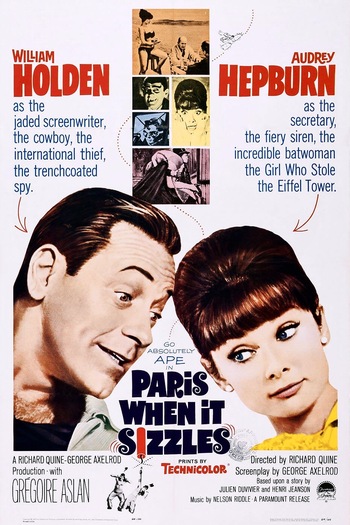
A 1964 American romantic comedy film directed by Richard Quine and reuniting the stars of Sabrina — Audrey Hepburn and William Holden — a decade later.
Richard Benson (Holden) is a Hollywood screenwriter who's been living it up in Gay Paree and now finds himself facing a deadline to complete a script for The Girl Who Stole the Eiffel Tower. Which he hasn't even started. He hires an agency typist, Gabrielle Simpson (Hepburn), to assist him, and over 48 hours they hash out a script and fall in love. As they do so, we see the film they write together, which is a ludicrous romp throwing together and sending up every movie cliché you can think of.
Tropes in this film include:
- Actor Allusion: There are lots of references to Hepburn and Holden's previous movies. Richard's initial idea for the ending of the movie is exactly the same as Breakfast at Tiffany's, right down to the cat. William Holden's casting as an alcoholic is unusually on-the-nose for this trope.
- Comically Missing the Point: Gabrielle's mother thought it was unhealthy for Gabrielle to have a thing for Dracula. Not because he's a vampire, but because "he's old enough to be your father".
- Creator Killer: In universe. In the inner film, Rick plots to steal the negatives and only working print of a film, and demand payment for their return. What he doesn't know is the film in question is an utter dud that the studio head is convinced will be this and ruin him.
- Creator Thumbprint: In universe, it's mentioned that Richard's screenplays always include a gratuitous Bathtub Scene. And The Girl Who Stole the Eiffel Tower is no exception.
- Credits Gag: The inner film has credits in which all the technical jobs are credited to "Little person". The actual film also has a credit for Audrey Hepburn's wardrobe and perfume.
- Decon-Recon Switch: While the inner film is a deconstruction of the elements of a romantic comedy (along with a bunch of other genres), the outer film plays them straight, albeit heavily lampshaded.
- Eiffel Tower Effect: The very first image we see of Paris is the Eiffel Tower. Lampshaded and discussed in short order.
- Fantastic Rank System: Throughout The Girl Who Stole the Eiffel Tower, Tony Curtis' character is put in his place by being told that if this were a film, he'd be a bit-player called "Second Police Officer". At the end, he is promoted to "First Police Officer", which in the film is an actual rank and causes everyone who'd previously mocked him to start treating him with respect.
- Foreign Remake: Adapted from the 1952 French comedy La fête à Henriette.
- Genre Shift: In-universe; when Gabrielle takes over writing The Girl Who Stole the Eiffel Tower, it swiftly changes from a spy drama to a vampire horror, to a western, to a sports movie, to a war movie. At which point, Richard steps in, pointing out that she's drunk and should really go to bed.
- The Law of Conservation of Detail: In the inner film, there's a sudden lingering shot of Gabby's lipstick. Inevitably, it turns out to be important later.
- Leaning on the Fourth Wall: Richard explains what a dissolve is, and what it's used for, immediately before one happens.
- Marty Stu: In universe. "Rick" in The Girl Who Stole the Eiffel Tower is blatantly an idealized version of Richard.
- Non-Indicative Title: The Girl Who Stole the Eiffel Tower does not involve a girl stealing the Eiffel Tower. Instead, it's the title of a film (in the film-within-the-film) which, we are told, does not involve a girl stealing the Eiffel Tower.
- Obvious Stunt Double: In the rooftop chase scene, Hepburn / Gabby's stunt double is pretty good, but the change back to the real Hepburn is (deliberately) very obvious.
- Only a Lighter: In The Girl Who Stole the Eiffel Tower, Gabby pulls a gun on Rick, who responds by making a great show of pulling and twirling what is implied to be a gun too, but turns out to be an ordinary lighter. Whereupon Gabby reveals that her "gun" is actually a lighter too, and they light each other's cigarettes.
- Ridiculous Procrastinator: Richard's deadline to deliver a script is only two days away and he hasn't even started it.
- Sealed with a Kiss: One of the tropes discussed in the frame story, which ultimately ends by using and lampshading it.
- Sexy Discretion Shot: Discussed and parodied. When Richard writes a scene that ends with the male and female leads on a bed, and a dissolve out, Gabrielle accuses him of using this. Richard responds that it's merely to show time passing and what the characters get up to in that time isn't important — they might just as well be playing Parcheesi. Dissolve back in to show them doing exactly that.
- Special Effects Failure: In universe. In the vampire sequence, there is no effort put into making the bats realistic.
- Strictly Formula: This is Richard's approach to writing a script, and the whole film is basically an illustrated discussion of this trope.
- Stylistic Suck: The entire film-within-the-film is built on this.
- Take That!: There are plenty of jabs at French New Wave cinema, starting with Gabrielle's description of a film called The Scrabble Game Will Not Take Place, and carried through Tony Curtis' recurring cameo as a new wave actor playing a cop.
- Titled After the Song: Paraphrased from a line in Cole Porter's "I Love Paris":I love Paris in the springtime
I love Paris in the fall
I love Paris in the winter when it drizzles
I love Paris in the summer when it sizzles - Troperiffic: The film-within-the-film takes every movie trope they could think of and runs with it. Some others are discussed along the way too.
